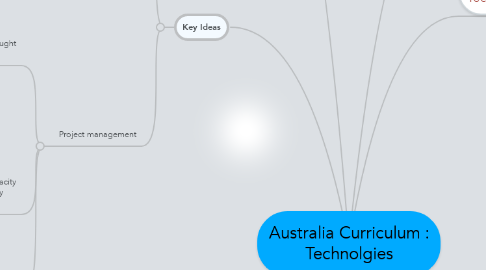
1. Aims
1.1. Destinations
2. Digital Technologies
2.1. Knowledge and Understanding
2.1.1. How data are represented and structured symbolically
2.1.2. the components of digital systems : software, hardware and networks
2.1.3. the ude, development and impact of the information systems in peoples lives
2.2. Processess and Production Skills
2.2.1. using a range of digital systems and their components and peripherals
2.2.2. collecting, managing and interpreting data when creating information and the nature and properties of data, how it is collected and interpreted
2.2.3. defining problems and specifying and implementing their solutions
2.2.4. creating and cimmunicating information especially online and interacting safely using appropriate technical and social protocols
3. Key Ideas
3.1. System thinking and the overarching idea: Creating preferred futures
3.1.1. focuses on system thinking to develop the technologies knowledge understanding and skills to provide a method for identifying and moving towards ethical, socially respinibible and sustainable pattens of living
3.1.2. Holistic approach: parts of a system is analysed individually to see the whole, interactions and interrelationships between the parts and how the parts influence the system
3.1.3. Design and Technologies and Digital Technologies provides opportunities for students to engage in predicting outcomes and impacts of technological decisions for current and future generations and their environments
3.1.4. Students creatively and actively design solutions
3.2. Project management
3.2.1. Students are explicitly taught how to manage projects
3.2.1.1. Planning
3.2.1.2. evaluating processes
3.2.1.3. considering constraints
3.2.1.4. risk assessment and management
3.2.1.5. decision making strategies
3.2.1.6. quality control
3.2.1.7. developing resource, finance, work and time plans
3.2.1.8. collaborating and communicating with others
3.2.2. essential element in building students capacity to successfully innovate in both technology subjects
3.2.3. Assessing and managing risk in technologies
3.2.3.1. Safe Addresses
3.2.3.2. aspects of health, safety and injury prevention (all year levels)
3.2.3.3. ergonomics, cyber safety, data security, ethical and legal considerations when communicating and collaborating online
4. Student diversity
4.1. All students are entitled to rigorous, relevant and engaging learning programs drawn from the Australian Curriculum: Technologies.
5. Curriculum
6. Cross- curriculum priorities
6.1. Sustainability
6.2. Aboriginal and Torres Strait Islanders histories and cultures
6.3. Asia and Australian engagement with Asia
7. General Capabilities
7.1. Literacy (LIT)
7.2. Numeracy (NUM)
7.3. Information and communication technology (ICT)
7.4. Critical and Creative thinking (CCT)
7.5. Personal and social capability (PSC)
7.6. Ethical understanding (EU)
7.7. intercultural understanding (ICU)
8. Rational
9. Design and Technologies
9.1. Knowlege and Understanding
9.1.1. The use, development and impact of technologies in peoples lives
9.1.2. Design concepts across a range of technologies contexts
9.2. Processess and Production skills
9.2.1. Critiquing, exploring and investigating needs or opportunities
9.2.2. Generating, developing and evaluating design ideas for design solutions
9.2.3. Planning, producing (making) and evaluating designed solutions
10. Band levels
10.1. Foundations to Year 2
10.1.1. students have opportunities to learn through purposeful and directed play to develop attitudes of care in relation to the places and resources they use. Through these processes they identify relationships between imagined and virtual worlds and the real world, between people and products, and between resources and environments.
10.1.2. They explore materials and technologies and use drawing and modelling to communicate their design ideas. Students will learn about and experience connections between technologies and the designed world.
10.1.3. they will begin to learn the importance of preparing precise instructions when solving problems using digital systems, creating ideas and information and sharing them online with known people.
10.2. Years 3 and 4
10.2.1. They respond resourcefully to a range of design and computing problems and situations using creative and innovative ideas to realise solutions. They communicate and record their ideas in diagrams and drawings using manual and digital technologies. They explain the main functions of their solutions and the materials, systems and technologies which could be used
10.3. Years 5 and 6
10.4. Years 7 and 8
10.4.1. students use technologies knowledge and understanding, technologies processes and production skills and design, systems and/or computational thinking to solve and produce creative solutions to problems, needs or opportunities. They communicate and record their ideas using a range of media and technologies
